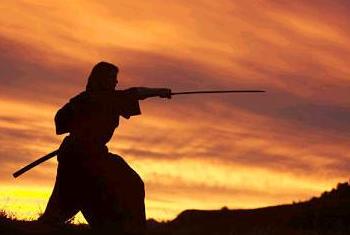Many of this film’s detractors, and even some of its fans, will take part in furious Cruise-bashing, making cracks about his perfect white teeth, his perfectly coifed hair, his limited acting abilities… This has happened with every single flick Tom Cruise’s ever appeared in and I must say that I once couldn’t stand the pretty-boy superstar either. Since “Jerry Maguire”, though, I’ve found Cruise to show much taste and range and I’ve liked (and often downright adored) every single movie he’s been in. Until now.
Throughout “The Last Samurai”, I never believed that I was watching a 19th century American soldier. First of all, everything about Cruise is thoroughly modern – including, yes, the perfect teeth and hair. Then there’s the underlying impression that Cruise is struggling very hard in every shot to finally get himself that Academy Award. Whereas in the last few years he’s showed surprising depth and restraint, here it’s all over-emoting, grand gestures and Oscar-clip acting-acting.
Cruise is basically reprising his “Born on the Fourth of July” character, or at least playing the great-grandfather of that drunken and embittered Nam veteran. Captain Nathan Algren is considered a Civil War hero, being trotted out and acclaimed in patriotic carnivals, but the bloodshed he’s witnessed is driving him into despair, cynicism and hard drinking. One day, he’s offered big money to go to Japan and train the Imperial troops in Western warfare and, with nothing to lose, he accepts. Algren and the men put under his command are soon sent to repress rebellious samurai but, even with the advantage of guns, they are quickly defeated.
For some unexplained reason, the American officer is kept alive by samurai leader Katsumoto (Ken Watanabe) and taken into their village. Algren is hit by the shakes and melodramatic flashbacks of a massacre of Indian “savages”, prompting him to cry for SAKE! to numb the pain. As time goes by, he overcomes his alcoholism and grows to respect his captors. He allows Katsumoto to practice his English with him, he gets Bonzai fever for the pretty sister of one of the samurai he killed (???), he befriends a cute kid, and now it’s me who wants to cry for SAKE! to wash away all this sentimental hogwash. The filmmakers allegedly revere the Japanese culture, but they’re only indulging in Oriental clichés about how “those people” are so different, all discipline, honor, tradition and spirituality. The samurai aren’t given any personality, they’re all perfectly noble, one-dimensional, DULL.
Eventually, after months of living by the samurai philosophy and studying the way of the sword, Algren is freed and goes back to his employers, who order him to lead the Imperial army again to crush the samurai. Ooooh, what suspense, I wonder what he will do? Couldn’t be that we’ll get a bullshit ending where, redeemed after fighting with the “savages” this time and being the improbable sole survivor of a slaughter where thousands of guns were fired directly at him, the White Man will self-appropriate the last samurai’s cause, single-handedly show the Emperor the error of his ways and go on to live happily ever after with the pretty widows and cute orphaned children of all the dead Japanese warriors who, unlike their White Savior, are unfortunately not bulletproof?
“The Last Samurai” is as uninspired and superficial as it gets, with pointless narration that spells out every little thought and emotion and a Hans Zimmer score that’s good in itself but is laid thick enough to drive one nuts. Edward Zwick makes matters worse by directing every scene like its an operatic climax, even though most of the events aren’t moving or exciting, let alone believable. See Nathan tell a Japanese soldier to shoot at him just to prove a point! See Nathan provoke a samurai henchman into giving him a beating for no reason! See Nathan lead a tribe of samurai to a certain death (except for him)! Try to understand why any of this is supposed to be heroic!
On a purely technical level, one can’t deny that the battles are impressive, involving huge numbers of extras with armors, horses, swords, bows and arrows. The picture was filmed in the same gorgeous New Zealand locations used in “The Lord of the Rings”, and John Toll’s cinematography is stunning as always. Yet there is no human connection and beyond their size, these action sequences don’t stand out in any particular way. (Ok, the ninja attack is pretty cool, but how can you go wrong with ninjas?) Try as he might, Ed Zwick is no Kurosawa; heck, he’s barely on the level of “Teenage Mutant Ninja Turtles III” director Stuart Gillard.

